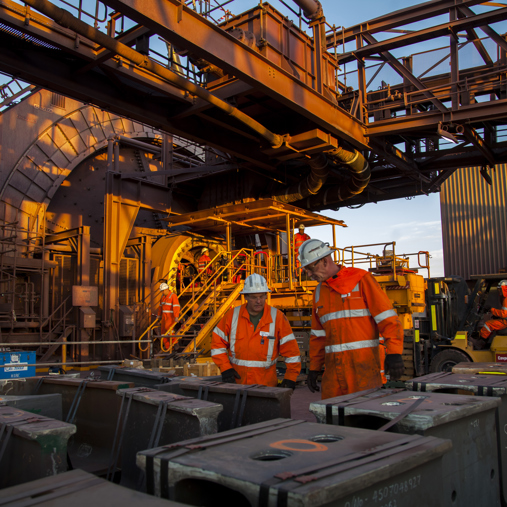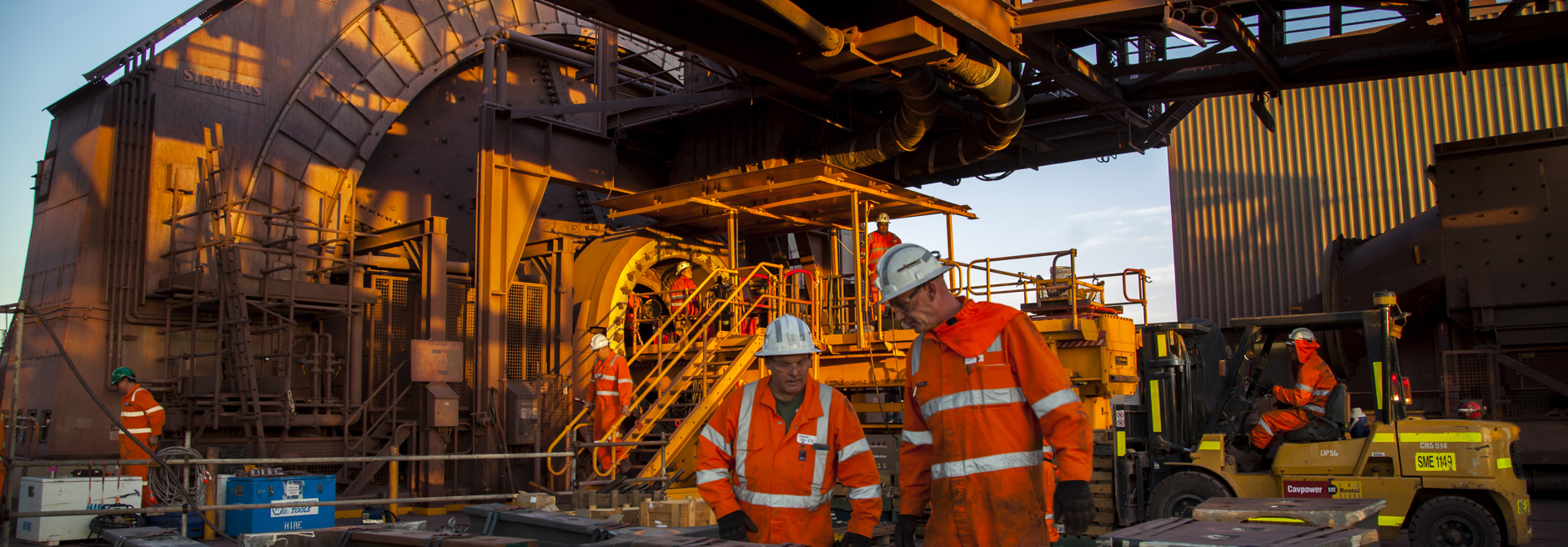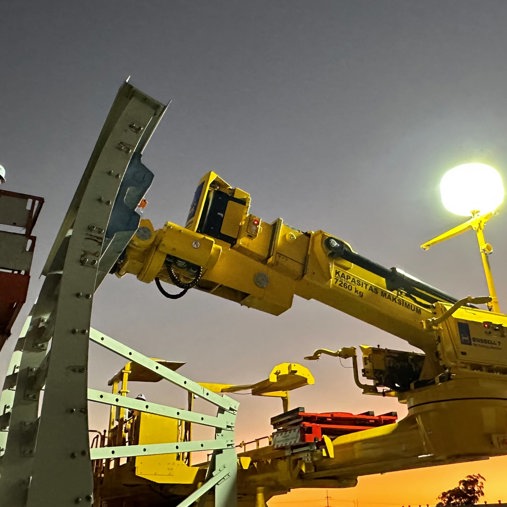
MILL RELINING BENCHMARKING SCORECARD
Benchmark your performance with RME’s free scorecard. Using industry data, it provides an indicative score for your reline duration—plus practical insights to reduce risk and improve mill availability.
15 July 2025
How RME built a web-based tool to provide sites with an external reference point for mill reline performance and spark exploration of how—and where—they might begin reducing hazardous risk and unlocking greater mill availability.

Mill relining safety and productivity have advanced markedly over recent decades, largely driven by mechanisation of the process. Yet at most sites, crews are still required to enter the mill to perform critical relining tasks. And while this remains common practice, mill relining continues to be one of the highest-risk maintenance activities in mineral processing.
At the same time, mills are pushing for greater throughput to meet rising global demand, all while managing the impacts of declining ore grades. Reline events—which often account for 2–5%, and in some cases up to 10%, of annual mill availability—remain strategic levers for improving maintenance efficiency, enhancing personnel safety, and maximising mineral concentrator availability.
Despite their operational significance, reline strategies are seldom scrutinised with the same rigour as issues such as liner wear, ore recovery, or throughput. However, RME’s filmed studies for customers seeking to optimise their reline practices consistently reveal significant variability in execution—alongside continued exposure to risks such as confined spaces, suspended loads, working at height, mobile equipment, reliance on ad hoc methods, and overlooked process inefficiencies—representing significant opportunities for improvement.
This is why now is the time to ask: What does your current reline performance reveal—and where might improvement begin?
To support these conversations, RME has developed and launched a new Mill Relining Benchmarking Scorecard—a simple, web-based tool designed to help sites get a gauge of how their reline durations and safety practices compare to similar mills globally, and to explore both immediate and longer-term improvement opportunities.
The tool draws from a global, but anonymised, dataset captured during filmed reline events across a diverse range of mills and geographies. Based on a user’s score, it generates a tailored—though general—set of recommendations, highlighting practical ways to reduce shutdown durations, improve crew safety, and increase mill availability.
In this behind-the-scenes interview, RME’s Content Marketing Manager, Elisa Davies speaks with RME’s Group Manager – Products, Stephen Gwynn-Jones, and Regional Applications Engineering Manager, Joel Bohorquez, about the data, insights, and intent behind the benchmarking scorecard—and the value-led conversations it is designed to spark.
Q1: Stephen, as RME’s Group Manager – Products, what prompted the development of this scorecard?
Q2: Joel, you built the data model for this scorecard web app. Where does the data come from—and how do we know it’s reliable?
Q3: What does the score actually represent?
Q4: Do you have any tips for the user when they are using the scorecard?
Q5: How are the safety and productivity suggestions generated?
Q6: What should operators take away from their score—especially if it’s lower than expected?
Q7: Stephen, what’s next for the tool—how do you see it evolving?

1. Stephen, as RME’s Group Manager – Products, what prompted the development of this scorecard?
RME has worked closely with sites around the world for decades and, in that time, has seen a lot of variability in how mill relines are executed. Along the way, we’ve collected a significant volume of data. What we saw was a need for something simple and more broadly accessible—a tool that could spark meaningful conversations around reline performance, particularly in terms of safety and duration.
"While most mine sites monitor reline duration internally, few have an external reference point. The scorecard concept was developed to help fill that gap. It’s not intended to replace site-specific studies, but rather offer a starting point for conversations and reflections—on how reline safety and efficiency might be improved, and how relining can be decoupled from the critical path during shutdowns. It’s a great little entry point—and a natural extension of our broader reline optimisation program that aims to reduce fatal risk and improve concentrator performance for our Customers."
2. Joel, you built the data model for this scorecard web app. Where does the data come from—and how do we know it’s reliable?
Yes, this is often one of the most common questions we get asked—can we trust the data? The industry dataset is based on over a decade of RME filming real-world relines across a wide range of operations globally, followed by discrete event analysis of those recordings. Using this data, we’ve constructed a probabilistic distribution model that reflects relining performance across the industry.
"Each data point is just that—a simple number—fully anonymised while still enabling meaningful comparison. And because the dataset is based on observed events—not estimations or simulations—it captures real-world variability across sites, mill types, and relining methods. This allows us not only to compare performance across sites, but—more importantly—to learn from those comparisons."
3. What does the score actually represent?
The score is simply a reference point designed to help you understand how your current reline practices align with broader industry performance. For reline duration, the score is out of 10. We’ve taken raw reline duration data—captured through our discrete event analysis studies—and plotted it on a statistical distribution curve. So, say you’re doing a high wear reline on a medium to large SAG mill and getting it done in 30 hours—that puts you in a high-performing range. But if it’s taking more than 120 hours, you’re likely falling into the lower band. A score of five represents about industry average. Then each score band unlocks a set of generalised suggestions aimed at helping sites explore opportunities to reduce reline duration—and ideally, decouple relining from the shutdown critical path.
On the safety side—this score is out of 6—and it’s a little less scientific. It’s based on the tools and methods your site’s currently using. For example, if you’re operating a mechanised mill relining machine but still slinging liners out manually, there’s still exposure to fatal risk—since personnel are still entering the mill and working under suspended loads—and you'd likely fall around a 3 out of 6, or roughly industry average.
However, if you're using a tool like the RUSSELL Claw or RUSSELL Forks Tool for worn liner removal, your score would reflect reduced risk exposure, as you've been able to remove crew from inside the mill during the hazardous muck-out phase. And if you've fully automated the reline—from first nut off to last nut on—without the need for personnel to enter the mill at any point during the operation, you'd be operating at industry best-practice level, scoring a 6 out of 6.
"But again, these scores aren’t a foregone conclusion or a precise analysis of your site—they’re simply an external reference point and a prompt. It’s about sparking curiosity. The goal is to help mill operators gain perspective on where they stand, identify areas for improvement, and initiate more informed conversations around achieving safer, faster relines."
4. Do you have any tips for the user when they are using the scorecard?
It’s a really simple tool to use—so honestly, there’s not much need for instructions!
The only thing I’d flag is that the data points reflect ‘reline duration’ only—not the full shutdown, which spans from mill shutdown and grind-out through to restart. Sometimes, activities outside the reline event itself can extend that window, but those aren’t factored into the score. What we’re measuring here are the reline-specific phases: knock-in, worn liner removal, new liner installation, and mill inching—from the removal of the first nut to the securing of the last. It’s within this window that we consistently see opportunities to reduce the often-significant hours reline crews are exposed to hazards and risk—while also unlocking meaningful gains in productivity and, ultimately, mill availability.
Each score simply unlocks a broad list of suggestions—some may apply, some may not!
They’re based on recurring themes observed across our safety and performance studies at mine sites, and are intentionally broad to accommodate a wide range of operational scenarios. While not prescriptive, they’re practical—intended to prompt reflection on the many levers available to improve performance.
"Whether a site is in the early stages of mechanisation or already adopting automation-enabling technologies, the combination of our domain expertise, our data-backed insights, and the RME Mill Relining System, we can always offer proven methods to support reline optimisation at every stage of the journey—and that’s exactly what these general recommendation sets are designed to encourage discussion around."
6. What should operators take away from their score—especially if it’s lower than expected?
We’d love Customers to see the score not as a grade—but rather a prompt. A site might score lower for a variety of reasons, from operational or plant design constraints, to simply not having yet explored certain process improvements. That’s okay. What matters is using the tool to spark reflection. Ask: What’s working well? What could be improved? What haven’t we explored yet? The goal isn’t to compare—it’s to learn. We want to encourage curiosity over comparison!
And the other important point is this: a lower score signals real opportunity. In some cases, there are low-hanging fruit—simpler, high-impact changes that can significantly shift the dial on risk reduction and performance. These often provide the ideal starting point for conversations around improving reline safety and efficiency.
7. Stephen, what’s next for the tool—how do you see it evolving?
We’ll continue to refine the model as we collect more data from our ongoing site-level studies. But beyond technical updates, it’s really about where the conversations go from here.
"With RME Advanced Technology and RME INSIDEOUT methodologies enabling relining to be performed entirely from outside the mill, we’re seeing significant reductions—and in some cases, the elimination—of confined space risks. We’re also seeing reline durations fall. It’s an exciting shift, and we’re passionate about supporting mine sites as they explore what’s possible next."
The final word
The RME Mill Relining Benchmarking Scorecard wasn’t built to provide site-specific analysis or prescribe site-specific solutions—it’s designed to prompt the right questions, grounded in real-world mill relining data.
Developed as a conversation starter, the tool offers an accessible starting point for sites looking to explore opportunities to optimise reline safety, duration, and mill availability.
Whether you’re in the early stages of refining your current reline practices—or working towards a long-term vision of fully automated relining—this tool offers a simple and credible place to begin.
A big thank you to Stephen and Joel for taking the time to walk us through this practical little tool and the thinking behind it.
Try the RME Mill Relining Benchmarking Scorecard today >
Want to talk it through? Contact the RME team >

Benchmark your performance with RME’s free scorecard. Using industry data, it provides an indicative score for your reline duration—plus practical insights to reduce risk and improve mill availability.

MILL RELINE DIRECTOR (MRD) discrete event capture, analysis and 'digital twin' simulation provides clear line of sight into the complex process of mill relining.

Our relentless pursuit to improve safety and productivity has driven us to engineer a future where relining is performed safely from outside the mill – at faster speeds than ever before.